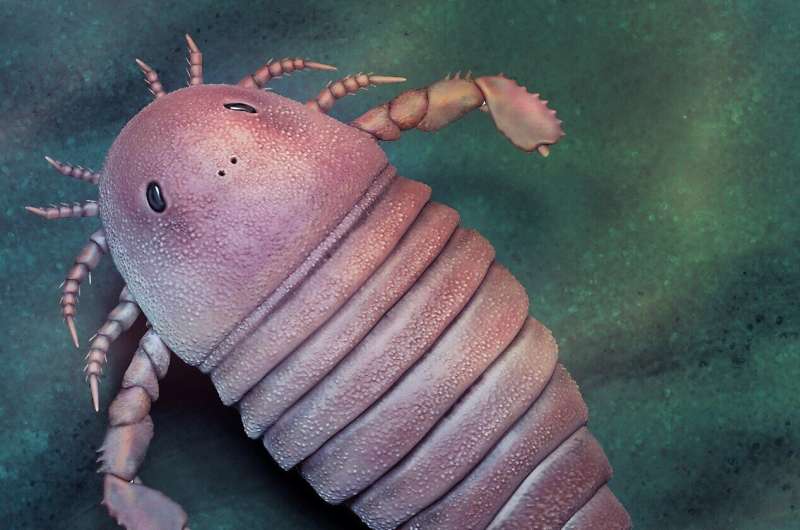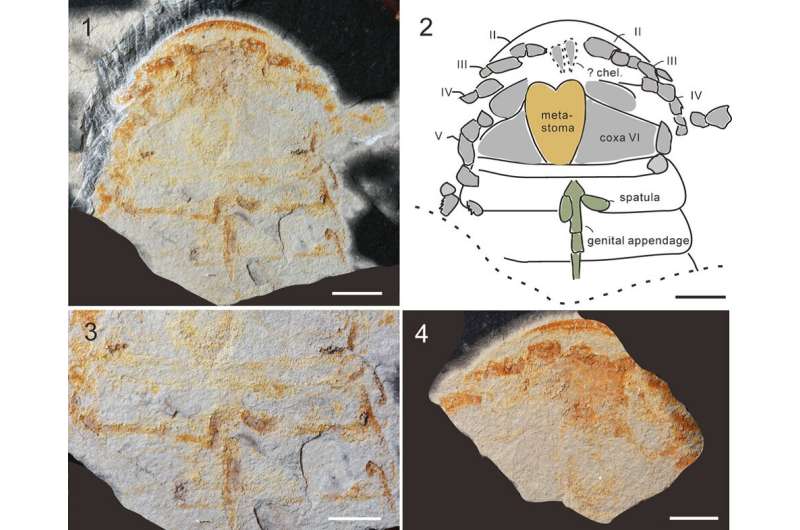This article has been reviewed according to Science X's editorial process and policies. Editors have highlighted the following attributes while ensuring the content's credibility:
fact-checked
peer-reviewed publication
trusted source
proofread
Earliest sea scorpion from China found in end-Ordovician Anji Biota in Zhejiang

Eurypterids (Arthropoda: Chelicerata), normally known as sea scorpions, are an important extinct group of Paleozoic chelicerate arthropods.
Researchers led by Profs. Zhang Haichun, Wang Bo, Zhang Yuandong, and Ph.D. student Wang Han from the Nanjing Institute of Geology and Paleontology of the Chinese Academy of Sciences (NIGPAS), in collaboration with their colleagues from the U.K., have described a new Ordovician eurypterid, Archopterus anjiensis, from the latest Ordovcian (Hirnantian) Anji Biota of Zhejiang Province, South China. It represents the first unequivocal Ordovician eurypterid recorded in China as well as the oldest one ever found in the country, adding new knowledge to the early evolution of eurypterids in Gondwana.
The study was published in the Journal of Paleontology on May 10.
Eurypterids first appeared in the Ordovician, attained their maximum diversity during the late Silurian and early Devonian, and became extinct at the end of Permian. With bizarre morphology and high ecological diversity, they occupied marine, freshwater, and even terrestrial environments, becoming an important medium for us to understand the transition of ecological environments in the Paleozoic.
However, Ordovician eurypterids are extremely rare. To date, only 12 species of Ordovician eurypterids are known in the world, so any reported occurrence is of great significance to understanding their early evolutionary history.

The current study reported a rare Ordovician eurypterid from the Wenchang Formation of Anji County, Zhejiang Province.
"Archopterus anjiensis is characterized by a parabolic carapace, Hughmilleria-type prosomal appendages, vase-shaped metastoma, and a three-segmented type A (female) genital appendage, estimated to be 15 cm long," said Wang Han, first author of the study.
Associated with diverse sponges, Archopterus anjiensis was found in a deep-water environment at a depth of several hundred meters. This occurrence, along with some Ordovician eurypterids from a normal marine environment, may indicate that some early eurypterids favored living in deeper waters than their post-Ordovician relatives.
In addition, Archopterus anjiensis represents the oldest adelophthalmid and extends the stratigraphic range of this family to the Late Ordovician (by about 10 million years), making Adelophthalmidae the longest-living eurypterid family (Ordovician to Permian), and indicates that adelophthalmids have been found in the widest range of habitats of all eurypterid groups.
This rare Ordovician sea scorpion from Zhejiang Province, along with continuous discoveries of eurypterid fossils in China, indicates that there is great potential for exploration of eurypterids in Paleozoic Gondwana areas.
More information: Han Wang et al, The first documentation of an Ordovician eurypterid (Chelicerata) from China, Journal of Paleontology (2023). DOI: 10.1017/jpa.2023.21
Journal information: Journal of Paleontology
Provided by Chinese Academy of Sciences





















